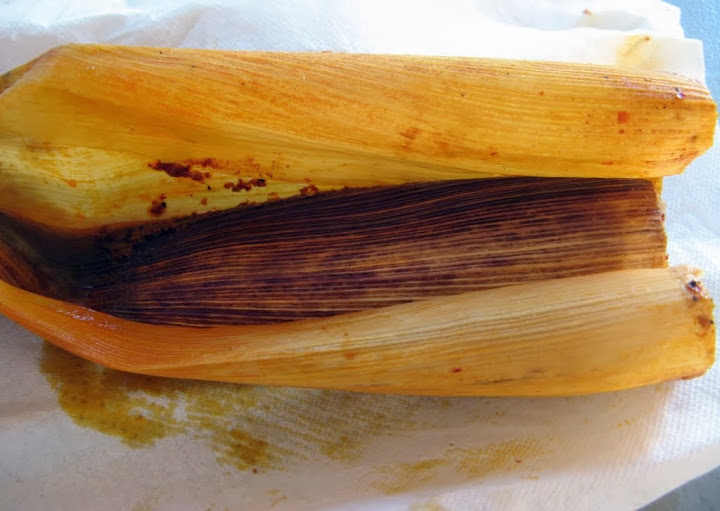 |
| Cochititos recíen nacidos. ¡Coman bien, mis amiguitos! |
The temptation was irresistible.
Nearly 7 kilos of pierna de cerdo at Costco. What a deal! But what to do with it?
I took it home, opened the plastic wrap, washed it in cold water and removed the stretchy netting that holds it together.
Then I cut it into 4 pieces, ranging from 1.5 kilos to 2.5 kilos.
I put all but the largest piece in freezer bags and focused on the 2.5 kilo piece. A smaller piece, just over a kilo, was earmarked to become Spicy Country Sausage. The others were frozen.
My focus was on Cochito al Horno, a savory, slow cooked dish redolent of herbs and spices, related to Cochinita Pibil, but with some differences.
It had been may years since I'd made it, from a recipe of Diana Kennedy's in her book, "Mexican Regional Cooking" (Originally published as "Recipes From the Regional Cooks of Mexico".) See page 41 of the former.
Cochito al Horno is fairly easy to make, with very satisfying results for your efforts.
This is Diana Kennedy's recipe, edited to reflect some small changes of mine.
4-5 chiles anchos, cleaned of seeds and veins
1/4 tsp thyme
4 Mexican or Californian bay leaves
(I'd like a tablespoon of Mexican orégano about here.)
10 peppercorns
6 whole cloves
20 (yes, twenty!) whole allspice
2 inch piece of cinnamon bark
4 peeled cloves of garlic, or a few more to taste.
1 1/2 tablespoons salt
2/3 cup vinegar (or part fresh orange juice plus juice of a few Mexican limes. I used the citrus juices plus some natural Vinaigre de piña).
5 pounds, approximately, pork roast (shoulder is best for this, but leg of pork (fresh ham, or pierna) will work. Avoid pork loin, as it's too lean and dry.
1 cup warm water.
Cover the chiles with boiling water and leave to soak until softened. Put the herbs, spices, garlic, salt and vinegar into a blender jar and blend thoroughly. Gradually add the soaked and drained chiles and blend until smooth, stopping occasionally to release the blades of the blender—you may need to add a little water, but the mixture should have the consistency of a loose paste.
Pierce the meat all over with the point of a sharp knife. Smear the meat liberally with the seasoning paste and set aside for a minimum of 4 hours, but preferably overnight. (Covered with plastic film, NOT aluminum foil, and refrigerate.)
Preheat the oven to 350º F. (Wrote Sra. Kennedy. I prefer a temperature of from 275º to 325º, for a slower cooking time, around 6 hours, which, in my experience, results in a juicier, more tender roast.)
Put the meat in a casserole (I just marinate and bake in the same casserole, thus avoiding one more vessel to clean.) and bake 4-6 hours, turning a couple of times and basting with the juices. Here's where the extra cup of warm water comes in, if needed. Don't let the juices dry up. The meat should be falling apart tender.
When the meat is done there should be plenty of sauce in the casserole.
Serve the meat sliced (or shredded) and topped with thinly sliced white onions and accompanied by shredded romaine lettuce. Plenty of hot tortillas, of course, or even French Bread.)
(I reached over from Chiapas to the Yucatán and made Pickled Red Onions, as written by Rick Bayless.)
Pickled red onions
3 large (about 1 1/2 pounds total) red onions, sliced 1/8 inch thick 2 cups fresh sour orange juice OR 1 1/3 cups fresh lime juice plus 2/3 cup fresh orange juice.
Simple pickled onions. While the meat is cooking, prepare the onions. Scoop the onions into a non-aluminum bowl. Pour boiling water over them, wait 10 seconds, then pour the onions into a strainer. Return the drained onions to the bowl, pour on the sour orange juice (or the lime-orange combo) and stir in 1 1/2 teaspoons salt. Cover and set aside until serving time. (I squirted in a couple of scant teaspoons of homemade Habanero Vinegar. -DC)
3 large (about 1 1/2 pounds total) red onions, sliced 1/8 inch thick 2 cups fresh sour orange juice OR 1 1/3 cups fresh lime juice plus 2/3 cup fresh orange juice.
Simple pickled onions. While the meat is cooking, prepare the onions. Scoop the onions into a non-aluminum bowl. Pour boiling water over them, wait 10 seconds, then pour the onions into a strainer. Return the drained onions to the bowl, pour on the sour orange juice (or the lime-orange combo) and stir in 1 1/2 teaspoons salt. Cover and set aside until serving time. (I squirted in a couple of scant teaspoons of homemade Habanero Vinegar. -DC)
At our Cochito al Horno meal, I accompanied the main course with frijoles negros, lechuga orejona (romaine lettuce) arroz integral, y tortillas caseras hechas a mano.
 |
| Cochito al Horno y Cebollas Moradas Encurtidas |
 |
| Frijoles negros y arroz integral; lechuga dimly seen. |
 |
| Agua de Melón. Image from Food Network |
 |
| Better than carnitas: Cochito al Horno |










































